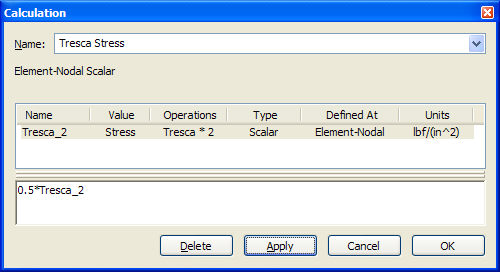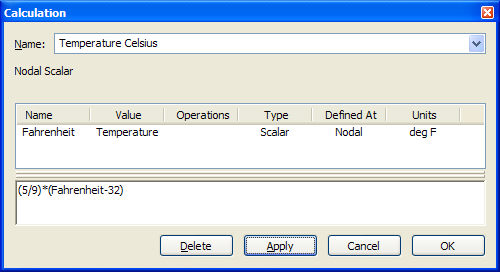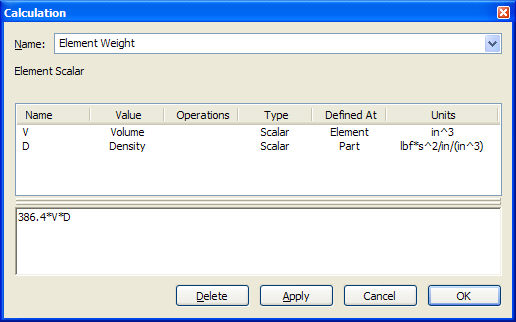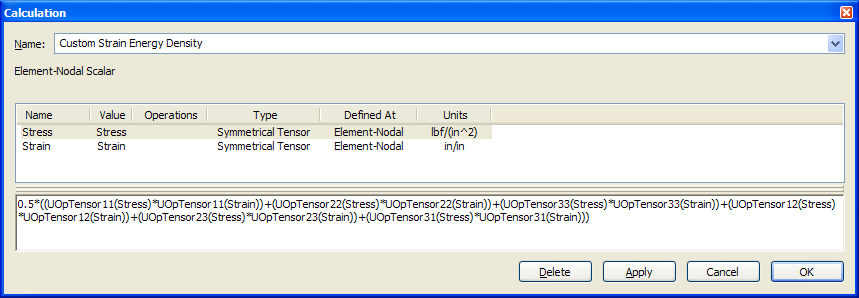Below are four example uses of custom results.
Create Contours of Tresca Stress
The Results Stress
Stress Tresca*2 command will provide a contour of twice the Tresca stress. To view a plot of the actual Tresca stress values you can multiply the existing Tresca*2 result by 0.5. This is shown in the following image. The custom result Tresca Stress was created and a variable, Tresca_2, was created and was assigned to the Tresca*2 result from the Results for Active Window pull-out menu. A formula was created which multiplies the calculated value by 0.5.
Tresca*2 command will provide a contour of twice the Tresca stress. To view a plot of the actual Tresca stress values you can multiply the existing Tresca*2 result by 0.5. This is shown in the following image. The custom result Tresca Stress was created and a variable, Tresca_2, was created and was assigned to the Tresca*2 result from the Results for Active Window pull-out menu. A formula was created which multiplies the calculated value by 0.5.

Convert Temperature Results from Fahrenheit to Celsius
Another possible application of the custom results is to convert results to another unit system. The image below shows the setup of a custom result that will provide a temperature profile in degrees Celsius from a model that was analyzed in degrees Fahrenheit. The custom result Temperature Celsius was created and a variable, Fahrenheit, was created and was assigned to the temperature result from the Results for Active Window pull-out menu. A formula was created which converts the calculated value to Celsius.

Calculate Element Weight
The weight of each element is the product of the mass density, element volume and the gravitational constant. There are two ways to create a custom result to show a contour of element weight. The first way is shown in the image below. The custom result Element Weight was created. A variable, V, was created and was assigned to the volume result from the Results for Analysis Type pull-out menu. A variable, D, was created and was assigned to the density result from the Results for Analysis Type pull-out menu. A formula was created which multiplies these values by 386.4, the acceleration of gravity (in/s 2 ).

 Analysis
Analysis Weight And Center-of-Gravity). This occurs because the formula includes the value Volume which is calculated by the Weight And Center-of-Gravity command.
Weight And Center-of-Gravity). This occurs because the formula includes the value Volume which is calculated by the Weight And Center-of-Gravity command. The drawback of this approach is that to use this result for a model built in metric units, you will need to change the 386.4 to a different value. We can avoid this issue by using AGSDB queries. In the custom result shown in the image below, the D variable was changed to the AGSDB query of Material(/p).General.Density.Mass. The /p designates that this value will vary with part number. This will allow this result to be used for assembly models consisting of multiple materials. (Note: The method used for obtaining the density in the previous example is also valid for multiple materials. This is simply showing an alternate approach). Also, a third variable, G, was created. This variable was assigned an AGSDB query of LinearStress.Master.Loading.Gravity.Static.Value. This value in the database will always be in the units of the model. Therefore the custom results are applicable to all models, regardless of the unit system. The variable G replaced the constant in the formula.

Calculate Strain Energy Density
For this example, we will verify the Result environment's calculation of the strain energy density. This is calculated as half of the sum of the products of the individual stress and strain tensors. The image below shows the setup of the custom result. The custom result Custom Strain Energy Density was created. The variable Stress was created and was assigned to the stress result from the Results for Analysis Type pull-out menu. The variable Strain was created and was assigned to the strain result from the Results for Analysis Type pull-out menu. The UOpTensorXX(x) function was used where XX is the component of the stress and strain tensor and x is either the Stress or Strain tensor variable. The values calculated from this equation match the strain energy density.
